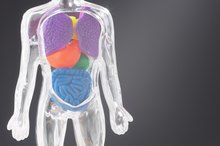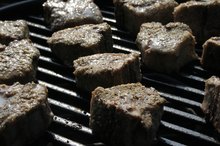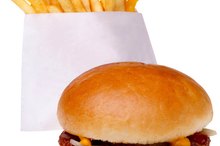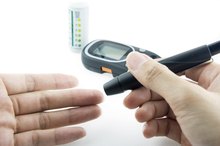How Are Nutrients Absorbed in the Body by the Stomach?
Food provides the fuel you need to perform all functions of living. The nutrients that food gives you, from vitamins to proteins, have specific functions in the body that keep you healthy and support your body's systems. But your body cannot use the nutrients you eat until it breaks them down in small pieces to then absorb them. Your stomach plays a crucial role in digestion and absorption, but it is only a part of the larger digestive system.
The Digestive System
The stomach is the third stop for food along the digestive tract. The digestive tract begins in your mouth and goes down through the esophagus, continuing into the stomach, small intestine, large intestine, rectum and then ending at the anus, where waste is eliminated. The digestive tract also includes a layer of smooth muscle that moves the food from the beginning to the end of the tract. Without the muscle, the food would not be able to get from the esophagus to the stomach. The entire digestive tract is approximately 30 feet long in an adult. The pancreas and liver also assist digestion by making digestive juices the body uses to break down food. The gallbladder stores the digestive juices the liver makes.
Digestion
Steps of Food Digestion
Learn More
Digestion is a necessary part of the absorption process. Food first enters the stomach after you chew and swallow it. The stomach stores the food and liquid you swallow and mixes it with digestive juices that the stomach makes. The muscles of the stomach mix the contents up to break them down into smaller pieces so the nutrients can be absorbed. Nutrients include vitamins, minerals, fats, carbohydrates and proteins. Different types of nutrients need more or less time to be processed by the stomach and small intestine before being absorbed through the intestinal walls. Carbohydrates require the least amount of time in the stomach to digest. Protein needs more time and fats take the longest.
Nutrient Absorption
The stomach breaks food down and passes it to the small intestine. Nutrients enter the bloodstream through fingerlike projections called villi that are along the inner wall of the small intestine. Your body absorbs most of the nutrients during the process of moving the food from the stomach to the small intestine, but the large intestine does absorb some nutrients. The main job of the large intestine is actually to remove water from undigested matter and to form solid waste for your body to excrete. However, the colon, which is part of the large intestine, does contain bacteria that assist in digesting any remaining food that reaches the large intestine.
Elimination
What Are the 19 Steps in the Digestion of Food?
Learn More
The rectum is at the end of the digestive tract. It is part of the large intestine. The rectum stores feces until you have a bowel movement and release waste products through the anus. Your body removes all the nutrients it can from food and absorbs them before the food reaches the rectum. Anything left over your body can't use and therefore eliminates.
Related Articles
References
Writer Bio
Sarka-Jonae Miller has been a freelance writer and editor since 2003. She was a personal trainer for four years with certifications from AFAA and NASM. Miller also worked at 24 Hour Fitness, LA Fitness and as a mobile trainer. Her career in the fitness industry begin in 2000 as a martial arts, yoga and group exercise instructor. She graduated cum laude from Syracuse University.









